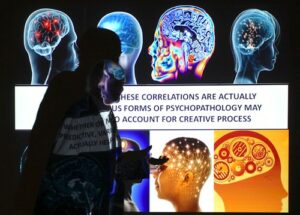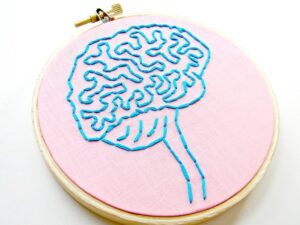Chapter 1: History of Psychopathology Disorders and Assessments
Overview

Psychopathology is the study of abnormal mental states, which has provided insight to psychiatric disorders and guided the progress of psychiatry (Schultze-Lutter et al., 2018). This field also deals with treating psychological disorders like mood, anxiety, phobias, and psychotic disorders. APA defines psychological disorders as conditions where individuals experience significant disturbances in their thoughts, feelings, and behaviors; enough to impact their daily functioning. Those that specialize in psychopathology diagnose and treat these individuals; treatment varies from person to person (Saylor Academy).
Definitions
Here are some terms to know as you proceed (APA, 2022).
Supernatural Tradition
Historically, the assumption has been made that there are supernatural causes for the development of psychological disorders (Saylor Academy). The prominent theory earlier in human history was that a demon, evil spirit, or evil god possessed someone, causing these unexplained phenomena (OpenStax); something beyond the realm of science and human understanding was considered to blame.
Biological Tradition

The biological tradition suggests that there is a genetic predisposition toward psychological disorders (Saylor Academy). This perspective linked these phenomena with “genetic factors, chemical imbalances, and brain abnomalities” (OpenStax). There is research to suggest a genetic component does exist and current research is thriving in this area of psychological disorders (OpenStax).
Psychological Tradition
The diathesis-stress model from psychology believes that biology and psychology play a role in the development psychological disorders (Saylor Academy), to the point of predicting the likelihood of a disorder. This model says that the psychological variables are latent and complex statistical methods and instruments would need to be used (Telles-Correia & Sampaio, 2016). Additionally, there are complex psychosocial perspectives at play, like learning stress, negative self-talk, and environmental factors that play a role in these disorders (OpenStax).
Review these videos below to learn more about the early years of diagnosing this disorders and their classifications now.
References
American Psychological Association (2022). Biological therapy. APA. Retrieved on August 10, 2022 from https://dictionary.apa.org/biological-therapy
American Psychological Association (2022). Humanistic therapy. APA. Retrieved on August 10, 2022 from https://dictionary.apa.org/humanistic-therapy
American Psychological Association (2022). Cognitive behavioral therapy. APA. Retrieved on August 10, 2022 from https://dictionary.apa.org/cognitive-behavior-therapy
American Psychological Association (2022). Schizophrenia. APA. Retrieved on August 10, 2022 from https://dictionary.apa.org/schizophrenia
American Psychological Association (2022). Posttraumatic stress disorder. APA. Retrieved on August 10, 2022 from https://dictionary.apa.org/posttraumatic-stress-disorder
American Psychological Association (2022). Obsessive compulsive disorder. APA. Retrieved on August 10, 2022 from https://dictionary.apa.org/obsessive-compulsive-disorder
American Psychological Association (2022). Mania. APA. Retrieved on August 10, 2022 from https://dictionary.apa.org/mania
American Psychological Association (2022). Etiology. APA. Retrieved on August 10, 2022 from https://dictionary.apa.org/etiology
American Psychological Association (2022). Diagnosis. APA. Retrieved on August 10, 2022 from https://dictionary.apa.org/diagnosis
American Psychological Association (2022). Depressive disorder. APA. Retrieved on August 10, 2022 from https://dictionary.apa.org/depressive-disorder
American Psychological Association (2022). Bipolar disorder. APA. Retrieved on August 10, 2022 from https://dictionary.apa.org/bipolar-disorder
American Psychological Association (2022). Personality disorder. APA. Retrieved on August 10, 2022 from https://dictionary.apa.org/personality-disorder
American Psychological Association (2022). Mood disorder. APA. Retrieved on August 10, 2022 from https://dictionary.apa.org/mood-disorder
American Psychological Association (2022). Anxiety disorder. APA. Retrieved on August 10, 2022 from https://dictionary.apa.org/anxiety-disorder
Cherry, K. (2021, January 28). What is psychodynamic therapy. VeryWellMind. Retrieved on August 10, 2022 from https://www.verywellmind.com/psychodynamic-therapy-definition-uses-effectiveness-5094933
OpenStax College (n.d.) Mental health treatment: Past and present. Introduction to Psychology. Retrieved on August 10, 2022 from https://courses.lumenlearning.com/waymaker-psychology/chapter/mental-health-treatment-past-and-present/
OpenStax College (n.d.). Perspectives on psychological disorders. Hawaii. Retrieved on August 10, 2022 http://pressbooks-dev.oer.hawaii.edu/psychology/chapter/perspectives-on-psychological-disorders/
Saylor Academy (n.d.). Psychopathology. Introduction to Psychology. Retrieved on August 10, 2022 from https://learn.saylor.org/mod/book/view.php?id=33155&chapterid=13417
Telles-Correia, D. & Sampaio, D. (2016). Editorial: Historical roots of psychopathology. Frontiers in Psychology. https://doi.org/10.3389/fpsyg.2016.00905
UNSW eLearning (2020, September 14). Week 1 lecture 1 – Introduction to psychopathology [Video]. YouTube. https://www.youtube.com/watch?v=tdl0GDXEHU0
UNSW eLearning (2020, September 14). Week 1 lecture 2 – DSM Classification and assessment [Video]. YouTube. https://www.youtube.com/watch?v=HFWSstMIu-k
UNSW eLearning (2020, September 24). Week 1 lecture 3 – Early approaches to studying the mind [Video]. YouTube. https://www.youtube.com/watch?v=ZvTNM-cRfes
UNSW eLearning (2020, September 15). Week 1 lecture 4 – The 20th century and beyond [Video]. YouTube. https://www.youtube.com/watch?v=ZFToxD3_oN0
A group of disorders that have a central theme of worry, fear, and apprehension.
Condition that has a signature feature of emotional disturbance (examples: bipolar, depressive disorder, etc.)
A group of disorders that relate to the self interfering with long-term functioning and not limited to specific, isolated incidents. There are different clusters of these sort disorders but include disorders like antisocial, schizoid, or obsessive-compulsive disorders.
A group of mood disorders that alternate between mania and depressive episodes.
Sadness is the prominent symptom of these disorders.
The process of determining an individual's disease or disorder by recognizing and categorizing the symptoms experienced.
The cause and progress of a disease or disorder.
A general state of excitement, euphoria, often with impaired judgment or grandiose ideas.
Characterized by intrusive thoughts and rituals that to the point of impairing functioning.
Occurs when an individual experiences a traumatic event and then feels overwhelming fear, terror, or helplessness associated with triggered flashbacks, avoidance behavior, and physiological arousal.
Characterized by disturbance in thinking, emotional responses, and behavior.
An approach that encourages a deeper understanding of emotions and mental processes (Cherry, 2021)
A form of psychotherapy that incorporates cognition and learning with techniques from cognitive and behavioral therapies.
A combination of psychotherapeutic approaches that encourage the individual to grow and focus on their potential.
A form of treatment that attempts to alter physiological functioning, drug-related therapies.

